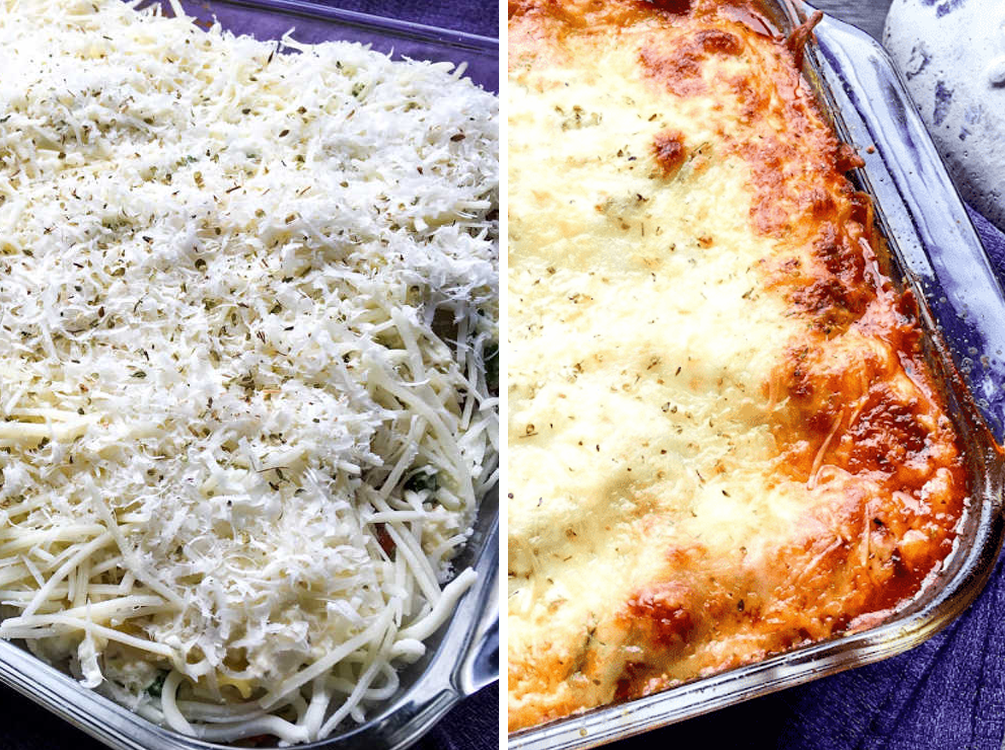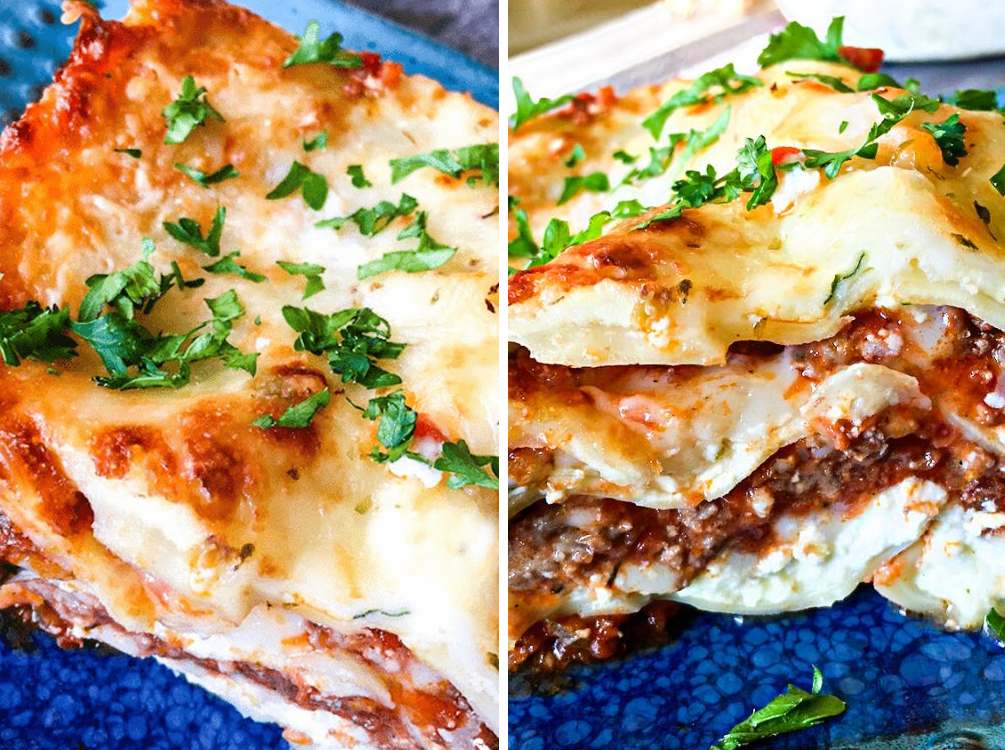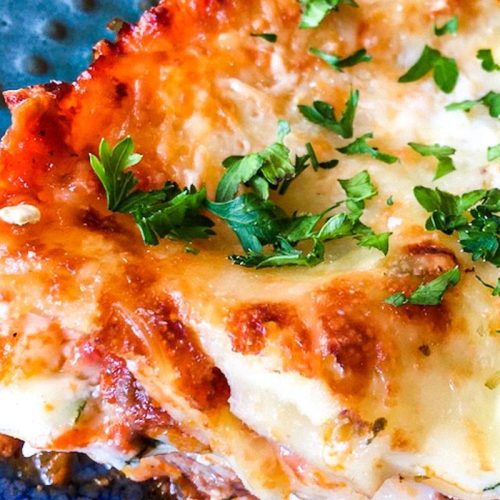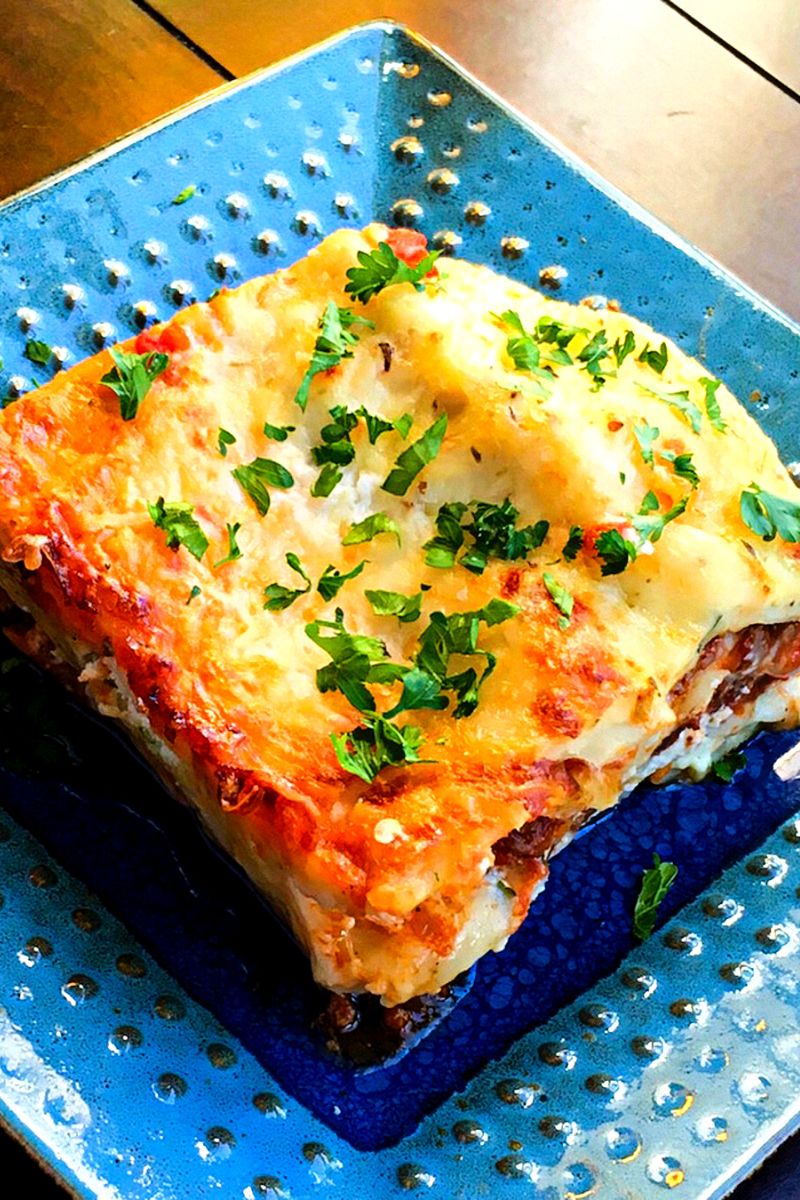All Question You Need
Meaty Lasagna Recipe is a classic Italian dish that has become a staple in households all over the world. It’s easy to make, customizable, and delicious. One of the most popular variations of lasagna is the meaty version, which is packed with savory ground beef and hearty tomato sauce. However, if you want to take your lasagna to the next level, why not try adding five different kinds of cheese? Here’s a recipe for a Meaty Lasagna Recipe that’s sure to satisfy your craving for comfort food.
This Meaty Lasagna Recipe is the ultimate comfort food. It’s rich, cheesy, and packed with flavor. The combination of different cheeses adds complexity and depth to the dish, while the meaty sauce provides a hearty and satisfying base. Serve it with a side salad and garlic bread for a complete meal that’s sure to please the whole family.

How to Make the Best Meat Lasagna
The star of this lasagna recipe is the meat sauce. You brown sausage and stir in lean beef and tomato sauce. We love the combination of sausage and beef. By combining the two, lasagna becomes beautiful and immensely satisfying. However, if you prefer meatless lasagna recipes, stay tuned.
What kind of cheese is good for lasagna?
There are several types of cheese that are commonly used in lasagna, and the best type of cheese for lasagna depends on personal taste and preference. Here are some of the most popular cheeses used in lasagna:
- Mozzarella: This cheese is commonly used in lasagna because it melts well and has a mild flavor that pairs well with tomato sauce.
- Ricotta: This cheese is creamy and adds a lightness to the dish. It’s typically mixed with other cheeses, eggs, and herbs to create a filling for the lasagna layers.
- Parmesan: This cheese is commonly grated and sprinkled on top of the lasagna for added flavor and a crispy, golden-brown crust.
- Provolone: This cheese has a mild and nutty flavor that pairs well with other Italian flavors. It’s often used in combination with mozzarella to add more depth to the cheese layer.
- Fontina: This cheese is a semi-soft cheese that has a nutty and buttery flavor. It melts well and is often used in combination with other cheeses to add more complexity to the dish.
Other types of cheese that can be used in lasagna include cheddar, gouda, blue cheese, and asiago. Ultimately, the best type of cheese for lasagna is one that you enjoy and that complements the other flavors in the dish.
Why do you mix an egg with ricotta cheese for lasagna?
Mixing an egg with ricotta cheese for lasagna helps to bind the cheese and create a creamy and cohesive filling for the layers of the lasagna. The egg acts as a binder, helping the cheese to hold its shape and not become too runny during baking. It also adds richness and flavor to the cheese mixture.
Additionally, the egg helps to give the cheese layer a slightly custard-like texture, which makes it more satisfying and delicious. The mixture of egg and cheese also helps to create a light and airy texture that balances out the richness of the meat sauce and the noodles.
Overall, mixing an egg with ricotta cheese for lasagna is a key step in creating a delicious and satisfying dish that is creamy, flavorful, and well-balanced.
What noodles are best to use for Meaty Lasagna Recipe?
- Dry Lasagna Noodles
- Oven Ready Lasagna Noodles
- Fresh Sheets of Lasagna Noodles
I prefer Oven Ready Noodles are my favorite because they are so simple to use. There is no draining, boiling, or cooling. I don’t notice any difference in how people feel about the texture. At the point when I’m not dinner preparing and needing to make a more exquisite and lighter Lasagna, I love New Sheets.
How do you keep the top layer of lasagna going hard?
To prevent the top layer of lasagna from becoming hard and dry, there are a few things you can do:
- Cover the lasagna with foil: For the first 20-30 minutes of baking, cover the lasagna with foil to prevent the cheese and noodles from drying out. This will allow the lasagna to cook evenly and prevent the top layer from becoming too brown.
- Add extra sauce: Before baking, add a little extra sauce to the top layer of the lasagna. This will help to keep the noodles moist and prevent them from drying out. It will also create a nice saucy layer on top of the cheese, which will prevent it from becoming hard.
- Add extra cheese: Sprinkle a little extra cheese on top of the lasagna during the last 5-10 minutes of baking. This will create a nice cheesy crust on top of the lasagna that will help to protect the noodles and prevent them from becoming hard.
- Tent with foil: If the top layer of the lasagna is browning too quickly, tent the dish with foil to prevent it from burning. This will allow the lasagna to continue cooking without the top layer becoming too hard.
Overall, the key to preventing the top layer of lasagna from becoming hard is to keep it moist and protected during the baking process. By following these tips, you can create a delicious and perfectly cooked lasagna every time.

How long do I bake lasagna?
The baking time for lasagna can vary depending on the recipe and the size of the dish. In general, most lasagna recipes require a baking time of 45 minutes to 1 hour. Here are some basic guidelines for baking lasagna:
- Preheat your oven to 375°F (190°C).
- Cover the dish with foil and bake for 30 minutes.
- Remove the foil and bake for an additional 15-30 minutes, or until the cheese on top is melted and golden brown and the noodles are tender.
- Check for doneness by inserting a knife into the center of the lasagna. If it comes out hot and steamy, with no resistance, the lasagna is done.
It’s important to note that the exact baking time can vary depending on the size and depth of the dish, so be sure to check on the lasagna frequently as it bakes. If you’re using a different recipe or changing the ingredients, adjust the baking time accordingly.
Once the lasagna is done, remove it from the oven and let it cool for at least 10-15 minutes before slicing and serving. This will allow the cheese to set and make it easier to cut and serve.
What temperature should lasagna be cooked?
Lasagna should be cooked at a temperature of 375°F (190°C) in a preheated oven. This temperature is hot enough to cook the lasagna evenly without burning the cheese or drying out the noodles.
It’s important to note that the exact temperature and baking time can vary depending on the recipe and the size of the lasagna. Be sure to follow the specific instructions for your recipe and check on the lasagna frequently as it bakes.
In general, lasagna should be cooked until the cheese on top is melted and golden brown, the noodles are tender, and the sauce is hot and bubbly. You can check for doneness by inserting a knife into the center of the lasagna. If it comes out hot and steamy with no resistance, the lasagna is done.
Allow the lasagna to cool for a few minutes before serving to allow the cheese to set and make it easier to slice and serve.
Should lasagna be covered when baking?
Yes, lasagna should be covered with foil for the first part of the baking process. Covering the lasagna with foil will help to keep the moisture in, which will prevent the noodles from drying out and becoming tough. It will also prevent the cheese from burning or becoming too brown before the rest of the lasagna is fully cooked.
For most lasagna recipes, you should cover the dish with foil and bake for the first 30 minutes. Then, remove the foil and bake for an additional 15-30 minutes, or until the cheese on top is melted and golden brown and the noodles are tender.
It’s important to note that the exact baking time and temperature can vary depending on the recipe and the size of the lasagna, so be sure to follow the specific instructions for your recipe.
Overall, covering the lasagna with foil during the initial baking process is an important step in creating a delicious and perfectly cooked dish.

5-Cheese Meaty Lasagna
Ingredients
- 1 pound ground beef
- 1 jar of your favorite tomato sauce
- 1 box of lasagna noodles
- 2 cups ricotta cheese
- ½ cup grated Parmesan cheese
- ½ cup shredded mozzarella cheese
- ½ cup shredded cheddar cheese
- ½ cup crumbled blue cheese
- 1 egg
- Salt and pepper
- Olive oil
- Fresh basil (optional)
Instructions
- Preheat the oven to 375°F (190°C).
- Heat a large skillet over medium heat. Add a drizzle of olive oil and the ground beef. Cook, breaking up the beef with a spatula, until browned and no longer pink.
- Add the tomato sauce to the skillet with the beef. Season with salt and pepper to taste. Simmer for 10-15 minutes, stirring occasionally.
- In a large bowl, combine the ricotta cheese, Parmesan cheese, mozzarella cheese, cheddar cheese, blue cheese, and egg. Mix well.
- Cook the lasagna noodles according to the package directions. Drain and rinse with cold water.
- Spread a thin layer of the meat sauce on the bottom of a 9×13-inch baking dish
- Arrange a layer of lasagna noodles on top of the sauce, overlapping slightly. Spread a layer of the cheese mixture over the noodles.
- Repeat with another layer of sauce, noodles, and cheese mixture, until all the ingredients are used up. The top layer should be the cheese mixture.
- Cover the baking dish with aluminum foil and bake for 25 minutes.
- Remove the foil and bake for an additional 10-15 minutes, or until the cheese is golden brown and bubbly.
- Let the lasagna cool for a few minutes before slicing and serving. Garnish with fresh basil, if desired.

